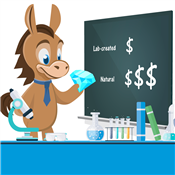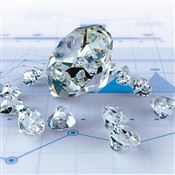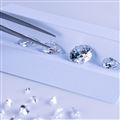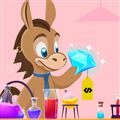Lab Created Diamonds vs Natural
With lab diamonds just a fraction of the price of natural diamonds, is it right for your engagement ring? Read this guide first to understand the differences.
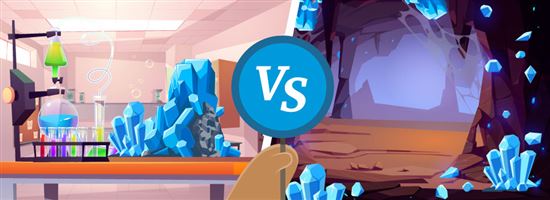 |
Looking to get the most out of your engagement ring budget? You've probably heard that lab diamonds are a lot cheaper. But are they just as good?
There are still a lot of misunderstandings about lab diamonds. Because they're also known as synthetic diamonds, some people question if they're real.
Here is an unbiased look at lab-created diamonds vs natural diamonds, so you can make the right decision.
Lab vs Natural Diamonds Comparison
Natural diamonds and lab-created diamonds have the same physical and chemical properties, so they are every bit the same gemstone. The main difference is in how it's made. Because of this, lab diamonds are much cheaper.
First, here's a quick overview of how natural and lab diamonds differ (and are the same), and their pros and cons.
| Natural Mined Diamonds | Lab-Created Diamonds | |
|---|---|---|
| Creation | Formed over billions of years deep under the earth's crust | Mass produced in labs over just weeks |
| Properties | Made of carbon atoms | Made of carbon atoms |
| Quality | Comes in a range of sizes and color and clarity grades | Comes in a range of sizes and color and clarity grades, but lab technology can produce higher-quality diamonds |
| Pricing | More expensive; $5,000 - $6,000 for a good value 1-carat diamond | 50%-60% (or even more) less than price of natural diamonds |
| Hardness | 10 on the Mohs scale | 10 on the Mohs scale |
| Fancy Color | Naturally colored diamonds are rare and expensive | Lab technology can make colored diamonds for much cheaper |
| Certification | Graded based on 4Cs | Graded based on 4Cs |
Lab diamonds, or synthetic diamonds, are NOT diamond simulants. Diamond simulants are things that look like diamonds (such as CZ and moissanite), but do not have the same physical properties. Lab diamonds and natural diamonds have identical properties.
Pros and Cons of Lab Diamonds
Pros:
- More than 60% cheaper than natural diamonds
- Can buy a larger diamond for same budget
- Colored lab diamonds are much more affordable
- No destructive mining
- Made in labs with fair wages
Cons:
- Not rare or special
- Low resale value (if at all)
- Lab growing is still energy intensive
Pros and Cons of Natural Diamonds
Pros:
- Each diamond is one-of-a-kind
- Seen as a luxury product
- More resale value
- Many jewelers have buy-back or trade-up programs
Cons:
- Much more expensive
- Environmental and ethical concerns about the mining industry
Now that we're covered the overview, let's get into the deeper discussion.
Should You Buy a Natural or Lab Diamond?
If lab diamonds and natural diamonds have no physical difference, which one should you get? There is no right or wrong answer. It mostly comes down to your budget and values.
Buy a lab diamond if:
- You want the biggest diamond you can get for your budget
- You like the idea of an ethical diamond made in safe labs with fair wages. You don't want to support the mining industry.
- You don't care about the resale value.
Buy a natural diamond if:
- You like the romantic idea of a diamond made by nature.
- You don't necessarily care about getting the largest stone possible. The meaning is more important instead.
- You may want to trade-up or sell your diamond in the future.
How Natural and Lab Diamonds are Made
Natural diamonds are special because they're created by the magic of mother earth.
Over billions of years deep under the earth's crust, extreme heat and pressure crystallized carbon atoms into diamonds. They're then rapidly brought to the earth's surface by deep volcanic eruptions. From there, the stones are mined, cut, and polished to become sparkling gems.
Lab diamonds are grown by replicating the conditions in a lab using machines. A diamond seed is placed into a chamber where heat, pressure, and gases make the diamond grow. This process happens in just a few weeks.
Once grown, you get a diamond with the exact same carbon structure and chemical properties as those formed in the earth.
Do Lab Diamond and Natural Diamonds Look Different?
Since lab diamonds have the same properties as earth-mined diamonds, there is no visual difference. You (or anyone else) will not be able to tell that a diamond is lab created.
Lab-created diamonds reflect light in the same way. They have the same brilliance, fire, and scintillation as natural diamonds.
Even gemologists can't tell the difference just by looking. They would need to use specialized machines to tell them apart. GIA has a screening device that can distinguish between natural diamonds, lab diamonds, and diamond simulants.
The easiest way professionals can tell is to look for a laser inscription. Legit lab diamonds have a tiny serial number on the girdle noting it's a lab diamond. But you can't see this engraving. It can only be seen under extreme magnification.
Lab Diamond vs Natural Diamond Pricing
The price for lab diamonds has gone down significantly since they were first introduced. They are now up to 80% cheaper than natural diamonds.
Here's an idea of the price difference (diamonds are all G color and VS1 clarity):
| Natural Diamond* | Lab Diamond* | |
|---|---|---|
| 1.0 carat round diamond | $6,200 | $1,600 |
| 1.0 carat princess diamond | $4,800 | $1,800 |
| 1.5 carat round diamond | $15,000 | $2,600 |
| 1.5 carat oval diamond | $13,500 | $2,800 |
| 2.0 carat round diamond | $28,000 | $4,700 |
| *Pricing based on typical market price of online diamond retailers as of 2023. | ||
You can see the crazy difference in price between natural and lab diamonds. For the same gemstones with the same properties, lab diamonds are the clear winner if you want to maximize budget.
What Size Diamond Can I Get for My Budget?
If you have a certain budget in mind, you may be wondering what's the difference in carat size between lab or natural diamonds.
Here's a chart with some guidelines.
| Budget | Natural Diamond | Lab Diamond |
|---|---|---|
| $1,000 | 0.4 carat | 0.7 carat |
| $1,500 | 0.5 carat | 0.9 carat |
| $2,000 | 0.6 carat | 1.2 carat |
| $3,000 | 0.7 carat | 1.5 carat |
| $5,000 | 0.9 carat | 2.0 carat |
| $7,500 | 1.1 carat | 2.5 carat |
| $10,000+ | 1.3+ carat | 3+ carat |
These estimates represent good value diamonds (G-I, VS1-VS2) from online retailers. If you're buying from a physical retailer, the pricing will most likely be higher.
Why Are Lab Diamonds so Cheap?
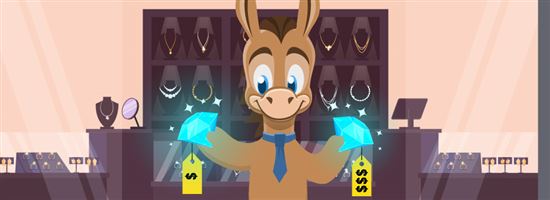 |
Natural diamonds are expensive because of limited supply and mining. Diamond mines have a lifespan - they can't just produce an unlimited number of diamonds. It also costs a lot to mine diamonds.
Plus, most diamonds found in mines are not gem quality. So it's rare to find diamonds large enough and in good enough quality for engagement rings. It takes 200-250 tons of earth to be mined for a single carat.
On the other hand, labs can make unlimited quantities of diamonds in a short amount of time. As lab technology gets better and better, they can produce larger and better quality lab diamonds for cheaper.
Are Lab Diamonds Just as Durable?
We've all heard that a diamond is forever, but what about lab diamonds?
Since lab diamonds have the same physical and chemical properties as natural diamonds, they are just as durable. Both rate 10 on the Mohs hardness scale, which is the hardest gemstone available.
This means you don't have to worry about your lab diamond getting scratched and cloudy. However, just like natural diamonds, they can still chip from a hard impact if hit just right.
Like with any precious jewelry, it's still important to be careful. With proper care and protection, your lab diamond should last forever.
Lab vs Natural Diamond Certification
Lab diamonds and natural diamonds are both graded the same way based on the 4Cs - carat, color, clarity, and cut.
The difference is that most lab diamonds are not certified by GIA and AGS. Usually, for natural diamonds, we recommend these two labs, as they have the highest grading standards and consistency. These lab certifications are more expensive, so lab diamonds are usually not sent to these labs.
Instead, you'll find that most lab diamonds are graded by IGI, GCAL, and HRD. In this case, IGI (International Gemological Institute) is probably the most reliable lab certification for lab diamonds.
Resale Value
This is one downside to lab-created diamonds. Since they are mass-produced in labs, the resale value is weak. There's no historical or rareness value.
In general, though, diamonds do not have much resale value, but lab diamonds are even worse.
With a natural diamond, you may be able to get 50% of the value back. Some diamond retailers have a buyback or trade-up program for natural diamonds, but it's usually not applicable to lab diamonds.
Are Lab Diamonds More Ethical?
We all know that the diamond industry has had a dark past. While blood diamonds are no longer an issue, there are still eco and human rights concerns about the diamond mining industry.
According to a report by Diamond Foundry (producer of lab diamonds), a single diamond carat requires 200-250 tons of earth to be mined.
Diamond mining has huge impacts on the environment, such as deforestation and soil erosion. Plus, a lot of mines still have problems like child labor, poor wages, and unsafe working conditions.
In comparison, lab diamonds are created in safe lab environments with fair wages. So in that sense, lab diamonds are the more ethical choice.
An in-depth article by JCK points out that both mining and lab growing are energy-intensive. In fact, both processes use about the same amount of energy. We still need more data to see if lab diamonds are truly more sustainable.
Also, this debate may not be as clear-cut as you think. The diamond mining industry provides jobs to millions. Many poorer regions rely on diamond mining to survive. If everyone shifted to lab diamonds, that's also taking away their economies and livelihood.
How Lab-Created Diamonds are Made
There are two methods to make lab diamonds. Both start with a carbon seed, just like a natural diamond.
- High Pressure/High Temperature (HPHT)
HPHT is an old method that started in the 1950s. This method imitates the natural environment where diamonds are created.Small diamond seeds are placed into a press that generates very high pressure and high temperature (over 2000°C). This grows the seeds into larger diamonds, like a sped-up version of what happens beneath the Earth's surface.
- Chemical Vapor Deposition (CVD)
This is a newer technology that started in the 1980s. CVD doesn't require extreme conditions, so it's more efficient. It can produce bigger and higher-quality diamonds more quickly.A small diamond "seed" is placed into a sealed chamber, which is filled with a carbon-rich gas mixture and heated to 800°C. The carbon is activated and attached to the diamond seed, atom by atom, until they grow into diamonds large enough for cutting.
These days, most lab diamonds for jewelry are made with the CVD method.
You can read more in-depth about these 2 methods and the differences from GIA.
Frequently Asked Questions
Are lab diamonds real?
Yes, lab diamonds are the same as natural diamonds with the same chemical and physical properties. They sparkle in the exact same way and have the same hardness. They are very much real diamonds.
Are lab diamonds the same as cubic zirconia?
Lab diamonds and cubic zirconia (CZ) are two completely different things. CZs are from a man-made material called zirconium dioxide. They only look like diamonds, but they have different properties.
CZs are not as hard as diamonds and can get scratched and cloudy over time. They also reflect light in a different way. They emit more rainbow sparkles than white sparkles.
Are lab diamonds the same as moissanite?
Moissanite is a completely different white gemstone. It looks nearly identical to diamonds, but has different properties. It originally came from meteors, but now is all lab-grown.
Moissanite is affordable (approx. $600 for a 1-carat stone), very sparkly, and almost as hard as diamonds. It's a great option if you want a real gemstone that looks like a diamond and will last forever.
Are lab diamonds valuable?
Lab diamonds don't have much resale value since they are produced in labs. You may be able to get something back, but you shouldn't see lab diamonds as an investment piece. Just enjoy it for the beautiful piece of jewelry it is.
Do lab diamonds have inclusions?
Just like diamonds from the earth, lab diamonds have flaws that naturally occur during the growing phase. When choosing a lab diamond, it's still important to look for one that is eye-clean. We recommend VS2 clarity for the best value.
Do lab diamonds get cloudy?
No, a lab diamond will not become cloudy. Lab diamonds are rated 10 on the Mohs hardness scale, just like natural diamonds. It will not get scratched up and cloudy.
In 2018, the Federal Trade Commission (FTC) expanded its definition of "diamond" to help prevent deception in jewelry marketing. FTC removed the word "natural" from its definition of a diamond. Both from mines and labs are diamonds, the only difference is their origin.[2]
Bottom Line: Which One Should You Buy?
Hopefully, this guide has provided you with a fair comparison of lab and natural diamonds. We're not saying one is better than the other. Certainly both have their pros and cons.
In the end, lab diamonds and natural diamonds are the same stones with the same properties. The decision may come down to your budget.
If you're looking to get the most bling for your buck, a lab diamond is the best choice, as prices are up to 70% cheaper. You can buy a larger and better quality stone for the same money.
If you're a purist, a natural diamond from the earth may give you that more special feeling - as long as you're willing to pay for it.
References
- ^ Bain & Company, The Global Diamond Industry 2018, Retrieved7/5/2021
- ^ Federal Trade Commission. FTC Approves Final Revisions to Jewelry Guides, Retrieved 4/3/2022
Anna G is a research director at CreditDonkey, a diamond jeweler comparison and reviews website. Write to Anna G at feedback@creditdonkey.com. Follow us on Twitter and Facebook for our latest posts.
Note: This website is made possible through financial relationships with some of the products and services mentioned on this site. We may receive compensation if you shop through links in our content. You do not have to use our links, but you help support CreditDonkey if you do.
|
|
|




